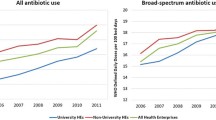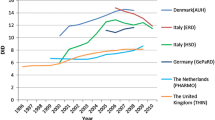Abstract
Background:
Regional variations in antibiotic consumption in outpatients have been reported previously, but nothing is as yet known about the regional distribution of antibiotic consumption in the hospital sector in Hungary. This study was designed to explore regional variations and investigate determinants of antibiotic consumption in hospital care in Hungary.
Materials and Methods:
Regional distribution-based antibiotic sales data were obtained for a 10-year period (1996–2005) for the 20 Hungarian counties. Systemic antibacterial use (Anatomical Therapeutic Chemical code: J01) was expressed as the number of defined daily doses (DDD) per 100 patient-days. The multiple linear regression model was applied to investigate the determinants of regional differences in hospital antibiotic consumption. Independent variables related to health care access, utilization of hospital resources, doctors’ workload, type of hospital care provided, and patient’s characteristics and infections were considered as possible determinants, and data on these variables were obtained for 2 years (2004, 2005). We also tested the association between hospital and ambulatory care antibiotic consumption in Hungarian regions using the Pearson correlation test.
Results:
For each year during the 1996–2005 study period, there were large and stable variations in total hospital antibiotic consumption (e.g., min–max1996: 16.0–28.2; min–max2005: 15.2–32.2 DDD per 100 patient-days) depending on the region. In the two developed models (Model 1 and Model 2), the number of reported infections accounted for 53% of the observed regional variations in hospital antibiotic consumption (Model 1), and the number of reported infections together with the case-mix index were responsible for 61% (Model 2) . Total antibiotic consumption in hospitals showed a positive correlation (R = 0.71, p = 0.002) with total antibiotic consumption in ambulatory care.
Conclusion:
The case-mix index and the number of reported infections explained some of the observed regional variations. However, the moderate value of the models in explaining these regional variations suggest that determinants which could not be explored in this preliminary study may also contribute to regional differences. Future studies should aim at collecting data for each individual hospital as well as data on possible determinants for hospital antibiotic consumption.
Similar content being viewed by others
References
Gonzalez A, Bischoff T, Tallent S, Sheke G, Ostrowsky B, Edmond MB, Wenzel RP: Antibiotic resistance in the community. J Hosp Infect 2003; 55: 156–157.
Harbarth S, Samore MH: Antimicrobial resistance determinants and future control. Emerg Infect Dis 2005; 11: 794–801.
Levy SB: Antibiotic resistance: consequences of inaction. Clin Infect Dis 2001; 33: S124–S129.
Bugnon-Reber A, de Torrente A, Troillet N, Genne D: ETUDAS Group Antibiotic misuse in medium-sized Swiss hospitals. Swiss Med Wkly 2004; 134: 481–485.
Vander Stichele RH, Elseviers MM, Ferech M, Blot S, Goossens H: European Surveillance of Antibiotic Comsuption (ESAC) Project Group Hospital consumption of antibiotics in 15 European countries: results of the ESAC retrospective data collection (1997–2002). J Antimicrob Chemother 2006; 58: 159–167.
de With K, Steib-Bauert M, Straach P, Kern WV: Is there significant regional variation in hospital antibiotic consumption in Germany? Infection 2006; 34: 274–277.
Blix HS, Hartug S: Hospital usage of antibacterial agents in relation to size and type of hospital and geographical situation. Pharmacoepidemiol Drug Saf 2005; 14: 647–649.
Matuz M, Benko R, Doro P, Hajdu E, Nagy G, Nagy E, Monnet DL, Soos G: Regional variations in community consumption of antibiotics in Hungary. Br J Clin Pharmacol 2006; 61: 96–100.
WHO Collaborating Centre for Drug Statistics Methodology: ATC classification index with DDDs 2005. Norwegian Institute of Public Health, Oslo.
“Gyógyinfok” website, maintained by the National Health Fund. Available at: http://www.gyogyinfok. Accessed 6 Aug 2007.
Bergman U, Popa C, Tomson Y, Wettermark B, Einarson TR, Aberg H, Sjoqvist F: Drug utilization 90% — a simple method for assessing the quality of drug prescribing. Eur J Clin Pharmacol 1998; 54: 113–118.
Filippini M, Masiero G, Moschetti K: Socioeconomic determinants of regional differences in outpatient antibiotic consumption: evidence from Switzerland. Health Policy 2006; 78: 77–92.
Website of the National Institute for Strategic Health Research. Available at: http://www.eski.hu/new3/adatok_en/adatok_alap_en.php. Accessed 26 July 2007.
de With K, Maier L, Steib-Bauert M, Kern P, Kern WV: Trends in antibiotic use at a university hospital: defined or prescribed daily doses? Patient days or admissions as denominator? Infection 2006; 34: 91–94.
Filius PM, Liem TB, van der Linden PD, Janknegt R, Natsch S, Vulto AG, Verbrugh HA: An additional measure for quantifying antibiotic use in hospitals. J Antimicrob Chemother 2005; 55: 805–808.
Benko R, Matuz M, Doro P, Viola R, Soos G: Hungarian hospital antibiotic consumption. Does it matter which measure? Pharmacoepidemiol Drug Saf 2006; 15: S285–S286 (abstract).
Müller-Pebody B, Muscat M, Pelle B, Klein BM, Brandt CT, Monnet DL: Increase and change in pattern of hospital anti-microbial use, Denmark. J Antimicrob Chemother 2004; 54: 1122–1126.
DANMAP 2005: Use of antimicrobial agents and occurrence of antimicrobial resistance in bacteria from food animals, foods and humans in Denmark. Available at: http://www.danmap.org/pdfFiles/Danmap_2005.pdf. Accessed: 2 Sept 2007.
SWEDRES 2005: A report on Swedish antibiotic utilisation and resistance in human medicine. Available at: http://soapimg.icecube.snowfall.se/strama/Swedres%202005.pdf Accessed 2 Oct 2007.
Rogues AM, Placet-Thomazeau B, Parneix P, Vincent I, Ploy MC, Marty N, Merillou B, Labadie JC, Gachie JP: Use of antibiotics in hospitals in south-western France. J Hosp Infect 2004; 58: 187–192.
Liem TB, Filius FM, van der Linden PD, Janknegt R, Natsch S, Vulto AG: Changes in antibiotic use in Dutch hospitals over a six-year period: 1997 to 2002. Neth J Med 2005; 63: 354–360.
EUROSTAT: Statistical Office of the European Communities. Available at: http://data.euro.who.int/hfadb/. Accessed 4 July 2007.
Health Care Systems in Transition. Available at: http://www.euro.who.int/Document/E84926.pdf. Accessed 26 May 2007.
Author information
Authors and Affiliations
Corresponding author
Rights and permissions
About this article
Cite this article
Benko, R., Matuz, M., Doro, P. et al. Hungarian Hospital Antibiotic Consumption at the Regional Level, 1996–2005. Infection 37, 133–137 (2009). https://doi.org/10.1007/s15010-008-7468-6
Received:
Accepted:
Published:
Issue Date:
DOI: https://doi.org/10.1007/s15010-008-7468-6




